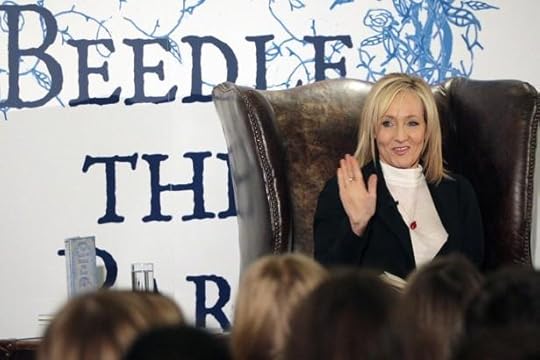Atlantic Monthly Contributors's Blog, page 97
August 18, 2016
Twitter's Crackdown on Users Promoting Terrorism

NEWS BRIEF Twitter suspended 235,000 accounts over the past six months for promoting terrorism, the social media company announced in a statement Thursday.
This latest round of suspensions brings the overall number of deactivated accounts to 360,000 since 2015, when Twitter first announced its efforts to crackdown on users violating the company’s terms of use.
More from the statement:
Since [February], the world has witnessed a further wave of deadly, abhorrent terror attacks across the globe. We strongly condemn these acts and remain committed to eliminating the promotion of violence or terrorism on our platform. … there is no one “magic algorithm” for identifying terrorist content on the Internet. But we continue to utilize other forms of technology, like proprietary spam-fighting tools, to supplement reports from our users and help identify repeat account abuse.
In February, the company announced it had suspended more than 125,000 accounts for “threatening or promoting terrorist acts, primarily related to ISIS” and increased the number of people whose job it was to review reports of accounts accused of abusive behavior. Over the past year, the company said daily suspensions have increased by more than 80 percent.
Earlier this year, President Obama called on tech leaders to curb the activity of terrorist groups and their supporters online, urging companies like Twitter to “make it harder for terrorists to use technology to escape from justice.”
According to Twitter’s rules, users who make threaten or promote violence, including terrorism, can be subject to temporary or permanent suspension.

The Road to Gawker's End

NEWS BRIEF Gawker.com, the news-gossip website that its best showcased the potential of independent online media and at its worst outed public and semi-public figures and purveyed the kind of snark seen in online comments sections, announced Thursday it will cease operations next week. The news comes days after Univision announced it was buying Gawker Media, the website’s parent company and six affiliated websites, for $135 million, and months after Peter Thiel, the Silicon Valley billionaire investor, revealed that he financed a lawsuit that ultimately bankrupted Gawker Media and its founder, Nick Denton.
The news was announced in a blog post by J.K. Trotter, a Gawker writer:
Nick Denton, the company’s outgoing CEO, informed current staffers of the site’s fate on Thursday afternoon, just hours before a bankruptcy court in Manhattan will decide whether to approve Univision’s bid for Gawker Media’s other assets. Staffers will soon be assigned to other editorial roles, either at one of the other six sites or elsewhere within Univision. Near-term plans for Gawker.com’s coverage, as well as the site’s archives, have not yet been finalized.
It’s a stunning reversal of fortune for the media company—and website—that not long ago was being hailed as the future of the media. Gawker.com, the flagship site, could be sharp, funny, incisive, and often broke the kinds of political and tech stories that were the envy of the traditional media landscape. It was the first news site to report that Rob Ford, the Toronto mayor, smoked crack on video, and then raised money online to buy from a source a video that showed Ford’s actions. It published the first expose on Silk Road, the since-shuttered shadowy online marketplace for drugs. It exposed the most toxic commenter on Reddit. (For a partial list of its good stories, go here.) And it also became among the first media online companies whose workers voted to unionize, setting the scene for others to follow.
But, at the same time, Gawker made enemies. It outed Thiel, and did the same to a media executive who happened to be the brother of a former U.S. Treasury Secretary. Traditional media organizations and Gawker’s own readers criticized this, but the website seemed to revel, at least publicly, in the criticism. Ultimately, it was one such story that was the beginning of the end for Gawker: Its decision in 2012 to publish a sex tape featuring Hulk Hogan, the pro wrestler who was born Terry Bollea.
Bollea sued, and in March a Florida jury awarded him $140 million. It was later revealed that Thiel had financed his legal effort—and the billionaire appeared to revel in the role he played in Gawker’s demise. In June, Gawker Media filed for Chapter 11 bankruptcy, and Denton followed suit earlier this month. Gawker and its websites were put up for sale: Ziff Davis, the publisher of PC Magazine, and Univision were the only two bidders. This week, Gawker Media was sold to Univision. Days later, Gawker.com said it would cease operations—14 years after it began its work.
Gawker Media’s other brands—Jezebel, Lifehacker, Kotaku, Deadspin, Gizmodo, and Jalopnik—will continue operations.

The U.S. Government's Verdict on Private Prisons

NEWS BRIEF The U.S. Department of Justice said on Thursday it will no longer house inmates in private prisons, a decision that comes a week after a report found privately run prisons have worse safety records and do not save taxpayers a significant amount of money compared with federally operated facilities.
The announcement was made in a memo from Deputy Attorney General Sally Yates that instructed the Bureau of Prison (BOP) officials not to sign any new contracts with private prison operators, and not to renew any existing contracts in the future. Within minutes of the news, the stock of the nation’s largest private prison companies, GEO Group, and Corrections Corporation of America, plummeted.
The memo read:
Private prisons served an important role during a difficult period, but time has shown that they compare poorly to our own Bureau facilities. They simply do not provide the same level of correctional services, programs, and resources; they do not save substantially on costs; and as noted in a recent report by the Department' s Office oflnspector General, they do not maintain the same level of safety and security.
The report Yates cited in her memo, conducted by the Office of the Inspector General, analyzed 14 private prisons in the United States that were used by the government to house prisoners. It found more contraband, lockdowns, and severe inmate punishment on average in the privately run facilities than those run by the BOP. It also found systemic deficiencies, and recommended the BOP had more work to do to ensure that “ federal inmates’ rights and needs are not placed at risk when they are housed in contract prisons.”
Media scrutiny has also given private prisons a bad reputation. Last month, in a 35,000-word article published by Mother Jones, a reporter took an undercover job as a corrections guard at a Louisiana facility and exposed a short-staffed institution that often denied inmates of medical care.
Private prisons reached their peak in 2013, when they held about 15 percent of all federal prisoners, or 220,000 people. That year, the government spent about $639 million on private-prison contracts. Since then the number of federal prisoners housed in private prisons has dropped to 12 percent.

August 17, 2016
The 38,000 Turkish Prisoners Being Freed

NEWS BRIEF Turkey will release 38,000 inmates from its prisons to make space for the thousands of people the government has arrested in connection to the attempted coup last month.
The decision, announced Wednesday by Justice Minister Bekir Bozdag, will apply to prisoners who have two years or less remaining on their sentence, show good behavior, and who committed their crimes before July 1—two weeks before members of the Turkish military attempted to overthrow the government.
The measure excludes prisoners convicted of murder, domestic violence, sexual abuse, or crimes against the state, according to the state-run Anadolu News Agency.
Turkey has been under a three-month state of emergency following the coup attempt led by a group of Turkish military officers, which resulted in the death of at least 265 people. Since July 15, President Recep Tayyip Erdogan has ordered the arrests of more than 13,000 people suspected of involvement in the coup, including members of the military, police, judiciary, academia, and media.
Erdogan is currently seeking extradition of Pennsylvania-based cleric Fethullah Gulen, who he accuses of orchestrating the coup, from the United States.

The Autopsy Report in a Chicago Police Shooting

NEWS BRIEF The unarmed black teenager who officers chased into a backyard in a Chicago suburb last month and fatally shot as he ran away was struck by a bullet in the back, according to the Cook County medical examiner’s office.
The report, obtained Wednesday by the Chicago Tribune, found that Paul O’Neal, 18, died of a single gunshot to the right side of his back. Footage released earlier this month captured O’Neal running from police and bleeding from his back as officers reached him and handcuffed him. Sharon Fairley, the head of Chicago’s police oversight agency, called the shooting “shocking and disturbing” the day police released the videos.
On July 28, officers gave chase to O’Neal because he was driving what police said was a stolen car. In the footage, O’Neal side-swipes a police cruiser, and two officers shoot into the car as he drives past. That action could be found to violate Chicago police policy, because firing into a moving vehicle—if that vehicle is the only weapon that poses a threat to officers—is not allowed by the department. O’Neal eventually crashed to a stop down the street and ran from the car into a backyard.
The incident was captured by nine body and dashboard cameras, and the department released the footage a week later. The release signaled a significant change for Chicago police, the force that once spent nearly a year trying to block the release of footage of the death of Laquan McDonald, a black 17-year-old police shot 16 times before he died in October 2014. After the legal struggle, the department promised to release future footage within 60 days of a shooting. The department delivered in O’Neal’s case, but footage from the camera worn by the officer who shot O’Neal is missing; police said the device was either turned off or had malfunctioned.
Chicago police has not publicly identified the officers involved in the O’Neal shooting. The Chicago Tribune has fought to release the names:
The Independent Police Review Authority declined to give the officers' names in response to a Freedom of Information Act request by the Tribune, releasing a document last week with the officers' names blacked out. The agency cited, among other parts of state records law, a clause that allows an agency to withhold information if disclosure would “endanger the life or physical safety of law enforcement personnel or any other person.”
The city’s Independent Police Review Authority (IPRA) is investigating the shooting and will recommend an action. Since Fairley became chief of the oversight agency in January, the IPRA has deemed a record-number of shootings unjustified. But those designations do not mean the officers involved will be charged with any violations. A July investigation by the Tribune found that even when the IPRA recommended action, it usually sought light punishments.

And the New Harry Potter Books Keep Coming

When Harry Potter and the Deathly Hallows was released in July 2007, many fans were prepared for the final book to be “The End.” Yes, there would be two new films adapting the novel for the big screen in 2010 and 2011. But the series’ author, J.K. Rowling, had always said the series would conclude with book seven.
Since then, there have been: a proliferation of stories on the companion website Pottermore, a real-life version of The Tales of Beedle the Bard (a fictional set of fables referenced in the series), a forthcoming Potter-world film trilogy starting with Fantastic Beasts and Where to Find Them (out in November), and a new play called Harry Potter and the Cursed Child, which wasn’t written by Rowling, and which had its script released in book form in July.
As per an announcement on Wednesday, fans can expect even more from the author: three new e-books about Hogwarts will be released on September 6, including Power, Politics, and Pesky Poltergeists; Of Heroism, Hardship, and Dangerous Hobbies; and Hogwarts: An Incomplete and Unreliable Guide. Given that Rowling has long seemed unwilling to put the wizarding world behind her for good, constantly offering new tidbits on Twitter or in interviews, this news shouldn’t be surprising. But after the Cursed Child debut, she made a point of saying that the play would, in fact, be the end of Harry’s story.
He goes on a very big journey during these two plays and then, yeah, I think we’re done. This is the next generation, you know … So, I'm thrilled to see it realized so beautifully but, no, Harry is done now.
In a very technical sense, Rowling was being truthful. The books will reportedly explore characters other than Harry: One will delve into the backstory of Dolores Umbridge and how Professor Slughorn met a young Voldemort. Another will revisit Professor McGonagall and Remus Lupin, while the last will focus on Hogwarts. But it seems disingenuous to say that these won’t, by extension, change Harry’s story in some way. And if fans can only hope to trust Rowling’s future announcements on a purely technical basis, then they might as well accept that the fictional magical world will evolve for years to come, perhaps in surprising ways. What if there’s a rock opera about Voldemort’s childhood? Or a new animated Netflix show about Harry and Ginny’s grandchildren? Or an augmented-reality mobile game where users can explore the Forbidden Forest, or battle Blast-Ended Skrewts, or eat an end-of-term feast in the Great Hall?
Considering much of the fan reaction to the script book for Harry Potter and the Cursed Child, perhaps Rowling staying away from Harry-specific stories (assuming she does) is a good thing. While reviews of the two-part play itself have been overwhelmingly positive, those who could only get their hands on the book seemed less delighted. Part of this was undoubtedly because scripts, especially early versions, rarely shine on the page like they do on stage. Part was because there were many fans who had mistakenly been expecting an actual novel. And yet there were others who felt that the play—with all its plot holes, occasionally odd dialogue, and apparent revisionism—fell well short of the ideal standards for a canonical Harry Potter tale.
If Rowling sticks to fleshing out little details and backstories, rather than shepherding along full-blown, brand-new story arcs, perhaps that can be a reasonable middle ground for both the author and fans. After all, a 79-page e-book will generally have lower stakes than a two-part stage production (especially one involving extensive time travel, alternate histories, and secret children). The move will please those hungry for any new Harry Potter stories. But an e-book is also a minor enough release that it can be ignored altogether by fans hoping to preserve the original story in their minds.
Either way, Potterheads can all but count on the likelihood of new magic-minded works, whatever the length or medium or subject. Stephen King told The New York Times that he felt Rowling was being influenced by her own love for the characters, and by her millions of fans’ eagerness for Harry to live on. “Writers feel responsibility to their readers, and some of that is a way of saying to the fans, ‘If you want a little more, I’ll give you a little more,’” he said. Perhaps this “little more” will just be random tweets or e-books or fake Daily Prophet articles. Or maybe one day the world will see whole new series about James Potter and Sirius Black’s adventures at Hogwarts. Either way, it seems clear that, for Rowling and for fans, “The End” is nowhere in sight.

Seven Steps to Swagger, With Amy Schumer

During Amy Schumer’s HBO special last October, the comedian referred to herself as, variously, a “fat tumbleweed,” a “garden gnome,” “one of those inflatable things outside a carwash,” and “Gilbert Grape’s mom.” When she appeared on Saturday Night Live earlier that month, Schumer joked in her opening monologue that “I have an 18-month-old niece—and we have the exact same body” and confessed that, under her dress, “it just looks like a lava lamp—like, things are just moving around and not really finding a home.” As she summed things up at the end of her set, to thunderous applause from SNL’s live audience: “So … I’m trash.”
Schumer’s particular brand of self-mockery is on the one hand, as The New York Times put it, “a comfortable kind of self-deprecation, born of insecurity but delivered with a confidence that takes the sting out and gives the listener a snug feeling of complicity.” That’s what made “12 Men Inside Amy Schumer,” in which a jury of dudes debates Schumer’s sexual appeal ad ridiculum, the most iconic sketch in a series full of them, and it’s what makes her superficially regressive observations actually, in their way, progressive—even radical. But the self-deprecation, which is directed at Schumer’s audience as much as it is at Schumer herself (the real object of mockery here is, of course, Society), has also been the most fraught aspect of Schumer’s profanity-laced, sexually explicit act. Here is a woman who has publicly embraced the feministic tenets of the moment, chief among them body positivity. Here is a woman who has used her fame to speak out against gun violence and internet bullying and the glib indignities Hollywood heaps upon its female stars. And here is that same woman in the spotlight at the Apollo, referring to herself as a “Jack-o’-lantern with tits.”
This is Schumer, the celebrity, shedding Schumer, the schtick.
So it is unsurprising that Schumer’s new essay collection, out this week from Gallery Books, is peppered with self-effacements and mini-masochisms. The Girl With the Lower Back Tattoo is named for Schumer’s “tramp stamp”—hers features tribal art of indiscriminate origin, courtesy of an artist who, inking under the influence, slightly skewed its angle—and in its pages Schumer compares herself to a Cabbage Patch Kid, a Garbage Pail Kid, “that eighties doll Kid Sister,” “an old sunken ship covered in plankton and kelp,” and “a still of Rupert Murdoch in a rocking chair.” Those jokes, though, are relatively rare. The book instead offers, overall—for author and reader alike—a compelling kind of catharsis: It is, contrary to the postmodern parfait that is Schumer’s standard act, decidedly un-layered. It is Schumer, the celebrity, shedding Schumer, the schtick. It is a memoir that is also an unapologetic paean to self-love. In that, The Girl With the Lower Back Tattoo finds a new way for Schumer to be radical: It treats feminine self-confidence not in the way it is too often regarded, as a BrainyQuotable truism or an inborn gift or a fuzzy aspiration or, indeed, a source of shame, but rather as a skill like any other—something that is developed and worked at and thus, most importantly, earned.
* * *
One one level, The Girl With the Lower Back Tattoo is simply another memoir, squarely in the funny-lady-sharing-stories-of-her-life manner of Poehler/Fey/Rhimes/Kaling/Dunham/Dratch/Greer and their ilk. And it features, as per the now-solidified conventions of that genre, a mix of the searing and the soaring: tales of minor embarrassment and major, of successes and failures, of flashpoints and turning points, all of them punctuated by jokes, cheeky lists of things liked and/or hated by the author, and bits of wisdom couched in protestations that “I have no advice to give.” But Schumer’s stories are really, particularly good. They concern failed romantic exploits (many); successful romantic exploits (an unnamed rock star, an unnamed hockey player, an unnamed wrestler, a carpenter named Ben); what it’s like to grow up rich; what it’s like to grow up no-longer-rich; what it’s like to have parents divorce; what it’s like to lose a friend, and wait tables, and be caught shoplifting, and live with weird Craigslist roommates, and be on comedy tour, and generally fake-it-’til-you-make-it.
Related Story

Amy Schumer and the Promise of the Ladyjerk
Schumer’s own version of the memoir sear-soar—one moment brings a detailed taxonomy of scones, the next several statistics about gun violence—is woven together with transitions that are often adept (“I wish I could Irish-good-bye my way out of this chapter,” Schumer notes, after professing her love for the maneuver) and sometimes not (“Anywhoozle…”). But the depth creates, overall, an impression of a person who is much, much more than a collection of witty one-liners and irony-laced self-deprecations. Along with the story heralded by Schumer’s admission that “one of the best nights of my life was just a one-night stand in Tampa,” we also get stories of her dad’s MS—of the disease’s onset (one episode came during an ill-fated family trip to Adventureland) and of its steady ravaging of her father’s body and mind. We get recollections of the time, at once short and too long, that Schumer spent living with an abusive boyfriend. (“I’m telling this story,” she notes, “because I’m a strong-ass woman, not someone most people picture when they think ‘abused woman.’ But it can happen to anyone.”) We get the story, too, of the sexual abuse she endured from an early boyfriend—the biographical basis of Schumer-the-performer’s coinage of the term “grape,” or “gray-area rape.”
And with that is the caricature presented in Schumer’s comedy insistently complicated—her “fat tumbleweed” jokes answered with realness and rawness and then varnished, lightly, with the humor that will make them more palatable, to reader and author alike. “I look at the saddest things in life and and laugh at how awful they are,” Schumer writes, “because they are hilarious and it’s all we can do with moments that are painful.” It’s fitting, then, that comedy itself is a repeat character in The Girl With the Lower Back Tattoo. Comedy is not just Schumer’s coping mechanism, and not just her career, but also her joy—and, in a way, her soul mate.
She wasn’t always good at it, though. Schumer had to learn, and earn, her swagger. And that is the most compelling aspect of her extremely compelling memoir: The book’s stories take for granted the relatively radical notion that “self-confidence,” so often, if so paradoxically, elevated as both as feminism’s means and its end, is … neither. It is a not a fuzzy goal; it is not a fuzzy tool. It is simply one other thing that can be learned and practiced and developed. “I had to learn (and I’m still learning) how to choose to be proud of who I am rather than ashamed,” Schumer notes. “Lucky for me, I’m a woman, so I’ve had the opportunity to practice this lesson over and over and over and over and over and over and over and over and over and over again.”
That’s the book’s most radical (and most feminist) message: Schumer had to learn, and thus earn, her swagger.
The book is full of stories of Schumer’s early forays into comedy, and full also of stories of her bombing in those efforts—in various venues, on various stages, with varying degrees of humiliation. “I think for anyone to become good at something,” she writes, “they have to fail a lot, too. And they have to be completely unafraid to fail or they’ll never make it to the next level.” It was allowing for those failures to happen, Schumer explains, publicly and repeatedly, that desensitized her to criticism, and that enabled her to fully inhabit her stage and her persona without worrying about the audience’s reaction. She taught herself confidence, failure by failure. And, in that, she demystified it. In her telling, no longer is “self-esteem” a kind of psychic unicorn, washed in the gauzy filters of ‘70s-era psychological aphorism; it is simply a skill like any other. One that you build. One that you improve. Put in the work, get the gains.
The Girl With the Lower Back Tattoo does at times (as its genre so often will) whiff of self-help. (“For anyone who has ever looked for love and found nothing more than a denim-on-denim-on-leather-wearing Hair Club for Men dude, I want to say, Love yourself! You don’t need a man or a boy or a self-proclaimed love expert to tell you what you’re worth. Your power comes from who you are and what you do!”) And it features, yes, the occasional, outright platitude. (“I am all of you,” Schumer declares at one point, without an ounce of irony.) On the whole, though, the book is, in addition to being entertaining and occasionally profane and very often laugh-out-loud funny, also more broadly important. It pulses with the recognition that so many comedians have been reluctant to acknowledge: that Schumer is, whether she wants to be or not, a role model. It is a personal memoir that manages also to be generous.
And that, in the end, is why Schumer named her book after her tattoo—her “tramp stamp,” and also her voluntary beauty mark, and also her youthful mistake. The memoir’s title is not just an acknowledgement of what any US Weekly creep-shot of “Amy Schumer caught in a teeny bikini on the beach” will reveal anyway; it is also, for its author, a declaration of pride. Schumer chose her book’s name, she explains, as a tribute to the evolutionary elegance of that most universal of things: screwing up. “I wear my mistakes like a badge of honor,” she writes, “and I celebrate them. They make me human.” They are the source of Schumer’s self-confidence. They are what allow her, finally, to swagger.

Too Fat for Egyptian TV?

NEWS BRIEF The Egyptian Radio and Television Union (ERTU), the country’s state-run broadcaster, issued temporary suspensions to eight female anchors for being overweight, the BBC reports.
ERTU said the suspensions, which went into effect this week, would give the women one month to slim down and achieve a more “appropriate appearance” before they would be allowed to reappear on air. Those suspended called the decision “humiliating” and “scandalous.”
“It is just an attempt to get rid of the successful [presenters] and retain others who present programs that have no strong content,” Khadija Khatab, a host for Egypt's Channel 2 who was affected by the suspension, told Al Watan.
Some have linked the suspension to ERTU’s rebranding efforts. When Safaa Hegazy, a former TV anchor, was appointed director of ERTU in April, she pledged to make the broadcaster more competitive despite losses to rival outlets. BBC has more:
At the state-owned Al-Ahram daily, journalist Fatma al-Sharawi says she thinks the policy should be applied across local TV stations. But author and academic Waheed Abdul Majid thinks the channel should focus on improving its content rather than the appearance of the presenters.
On social media, some users voiced support for the women, but others called them "bakabouzas", a term Egyptians use to describe overweight girls. One female Twitter user described ERTU head Safaa Hegazy as a "strong woman" for making the decision.
Women’s-rights advocates condemned the move as sexist, noting that only female anchors were affected. The Women’s Center for Guidance and Legal Awareness, a legal-rights group, said in a Facebook post the suspensions violated the anchors’ constitutional rights and called on the broadcaster to reverse the decision.
ERTU told local media that though the anchors would remain suspended, their pay and benefits would not.

The Capture of 'The Ghost,' a Criminal Legend of Miami's Cocaine Era

NEWS BRIEF During the years Pablo Escobar’s Medellín Cartel flooded Miami with cocaine, authorities say Anibal Mustelier was one of the city’s more deadly hitmen. In 1989, he allegedly machine-gunned a local businessman accused of taking money from the cartel. When that failed, he is said to have bombed the man’s car.
Mustelier is now 66, and has spent the past 26 years hiding as a fugitive from the FBI, the U.S. Marshals Service, and authorities in several countries. It was that knack for evasion that earned him the nickname “The Ghost.” He was so successful at hiding, in fact, that when officers in a Miami suburb caught a lead on a group of bank robbers earlier this month, they didn’t even know whom they were chasing.
Mustelier was arrested over the weekend with little attention. It was only Tuesday that local media outlets published the news. Of the robbery that brought down him down, the Miami New Times reported that Mustelier and his crew had cut a hole in the roof of a nail salon adjacent to a jewelry store. They planned to tunnel through another wall once inside, but they had:
... accidentally drilled through a metal pipe with wires inside, shorting out the lights in the entire shopping center.
Around 8:50 a.m. the next morning, a witness says he saw a "suspicious male" standing outside the store acting as a lookout and heard unknown voices emanating from inside the jewelry store. Possibly realizing they'd been seen, the alleged robbers bolted, carrying large black duffel bags with them and shielding their eyes with their hands.
After the robbery, a confidential informant helped officers record conversations with some of the suspected robbers, one of whom, to their surprise, turned out to be Mustelier. On Sunday, police raided the aging criminal’s home. Inside, they found jewelry, a bulletproof vest, gloves, a mask, and weapons.
Along with charges connected to the robbery, Mustelier has warrants out from an old bank robbery, and an attempted murder. Mustelier is believed to have masterminded one of South Florida’s largest robberies, that of the SunTrust Bank in Miami in 1996. The heist allegedly earned Mustelier and his associates $5 million, and a starring role in an episode of America’s Most Wanted.
Local police said Mustelier was at one time linked to former Cuban President Fidel Castro, working as an assassin for the government. He was believed to have hidden in Cuba for a long time, and possibly in Venezuela. In 2001 he was seen visiting family in the Miami area, but quickly vanished. Lately, Mustelier lived in a small, single-story home with his girlfriend.
Esperando la conferencia de prensa del FBI sobre la captura de Anibal Mustelier, el cubano más buscado del mundo pic.twitter.com/A6jdwjmh1Z
— Sergio N. Cándido (@sncandido) August 16, 2016

A Star Is Born Again, and This Time It’s Lady Gaga

Every iteration of the film A Star Is Born tells the simple story of the fickleness of fame. A young actress (or singer) arrives on the scene, meets and falls in love with a more famous man, and eventually eclipses him, becoming a marquee idol as he slips into self-destructive ruin. The movie has been made three times (in 1937, 1954, and 1976), each time to diminishing critical returns, with barely any variation in story, and yet with every new Hollywood generation someone looks to try again. On Tuesday, the fourth version was announced: Lady Gaga will play the ingénue and Bradley Cooper her love interest, with the latter also writing and directing, and presumably trying to find a new angle to justify the remake.
A new adaptation of A Star Is Born has been mulled for years, and the long-gestating concept is as Old Hollywood as they come: matching a famous, up-and-coming singer with an A-list male lead and a crusty, experienced director. That’s one thing that’s so baffling about the continued existence of the project. It’s such a backwards-looking piece of nostalgia: a love letter to a bygone era where a big name above the title was all a studio needed to guarantee box-office success. It’s impossible to imagine just what a fourth run at the simple story of A Star Is Born could unearth, even with the new spin of one of its stars sitting in the director’s chair. Unfortunately, as the countless remakes, reboots, and sequels show, it’s not the only way the industry is trying to revive its halcyon days.
For years, the remake of A Star Is Born was reportedly set to feature Beyoncé in the lead role with Clint Eastwood directing, a generational mismatch so profound it’s difficult to believe it came close to happening. Every lead actor du jour was rumored to be attached at one point or another, from Leonardo DiCaprio to Russell Crowe to Christian Bale. Beyoncé officially exited in 2012, a year before she released her self-titled album to critical acclaim. Before then, she’d been pursuing a typical path to movie stardom, appearing in broadly commercial projects like Dreamgirls, Cadillac Records, and Obsessed. No doubt Eastwood’s take on A Star Is Born would have adhered to that middle-of-the-road approach, rather than the more boldly personal music Beyoncé started making soon after.
Cooper, who had been floated as a possible on-screen partner for Beyoncé, stayed on board the project and eventually began lobbying to take over as director; eventually he hit on Lady Gaga to play his muse, emboldened by her Golden Globe win for acting in 2015’s American Horror Story: Hotel. Lady Gaga might seem an odd choice to play an up-and-coming star, considering that her first album came out eight years ago and her record sales have considerably cooled since then. But finding someone long-established to play the lead has long been the casting approach for A Star Is Born.
In 1937, Janet Gaynor, an Academy Award winner who was one of the earliest megastars of the silent era, saw her declining career revitalized by the original A Star Is Born, directed by William Wellman, co-written by Dorothy Parker, and starring Frederic March. It set a strict story formula every new edition followed: An actress arrives in Hollywood, meets and falls for a major star called Norman Maine, eventually elopes with him and finds massive success, winning an Oscar as his own career falls apart. Eventually, Norman dies, and in the film’s moving, bittersweet climax, she pays tribute to him at the premiere of her latest movie, introducing herself to her fans with the line, “Hello, everybody. This is Mrs. Norman Maine.”
Over the decades, the film’s rise-and-fall plot began to feel hopelessly outdated.
The 1954 version, directed by George Cukor, starred Judy Garland and James Mason, and ended in the exact same way: with the female lead tearfully tying herself to her lost husband as she reaches her apex of success. Garland’s character was also positioned as a former star making a big comeback, and the film reinvigorated her prospects in Hollywood (though she famously lost that year’s Oscar to Grace Kelly). While the 1937 film was critically acclaimed and nominated for Best Picture, the Garland version was mostly praised as a one-woman show, a dull plot vehicle that she elevated with her transcendent work.
The last Star Is Born, in 1976, turned its heroes into musicians, with Barbara Streisand playing the ingénue and Kris Kristofferson as the self-destructive rock star she marries. Though this version, directed by Frank Pierson, had a bestselling soundtrack and was one of the highest box-office grossers of the year, it was also derided by critics, and Streisand has only sporadically appeared in leading roles since. Over the decades its rise-and-fall plot began to feel hopelessly outdated, and the lead actress’ inexorable attachment to her wastrel of a husband shifted from merely mawkish to borderline sexist.
It’s hard to imagine Cooper’s updated version working the same way, with his heroine proudly announcing herself as “Mrs. Norman Maine” at the end, but it’s equally hard to see how the film will transcend its forebears. In 1937, the idea of a woman eclipsing her husband’s success was almost transgressive; not so much 80 years later. But this is far from the only Hollywood attempt to hearken back to the booming studio-system era: a remake of Ben-Hur hits theaters this week, The Magnificent Seven follows in September, and 20th Century Fox is hoping audiences are excited to once again go 20,000 Leagues Under the Sea. It seems that studios have accepted that the safest bet is a story that’s been well-told—even if it was last told before many theatergoers were born.

Atlantic Monthly Contributors's Blog
- Atlantic Monthly Contributors's profile
- 1 follower



